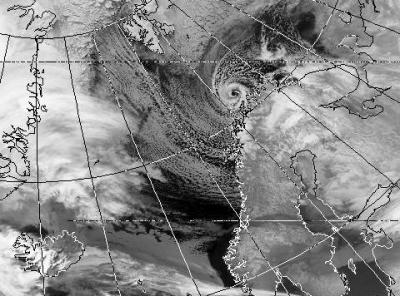Lows
Small cyclones forming over open sea during the cold season within polar or arctic air masses are called "polar lows." Typically several hundred kilometers in diameter, and often possessing strong winds, polar lows tend to form beneath cold upper-level troughs or lows when frigid arctic air flows southward over a warm body of water. Polar lows last on average only a day or two. They can develop rapidly, reaching maximum strength within 12 to 24 hours of the time of formation. They often dissipate just as quickly, especially upon making landfall. In some instances several may exist in a region at the same time or develop in rapid succession. In satellite imagery polar lows show characteristic spiral or comma shaped patterns of deep clouds, sometimes with an inner "eye" similar to those seen in tropical cyclones. Convective cloud bands occupy the surroundings (see figure below). Analysis of aircraft and radiosonde data collected during field experiments reveals that polar lows may possess warm cores. This finding, coupled with their appearance in satellite imagery, has prompted some investigators to refer to polar lows as "arctic hurricanes," although they seldom, if ever, possess hurricane strength winds.











No comments:
Post a Comment